Born and raised in the bush village of Lake Minchumina, Julie and Miki Collins draw on more than fifty years of experience in reflecting on changes they see in the wild lands they call home.

© Miki & Julie Collins
Living a subsistence lifestyle in the remote Lake Minchumina area northwest of Denali National Park and Preserve (Denali Park) since our birth in 1959 has given my twin sister Miki and me decades to observe environmental changes. As we ramble about gathering berries, fish, furs, game, firewood, and other wild supplies (as allowed under rural Alaska subsistence rights affirmed by Congress in the Alaska National Interest Lands Conservation Act), we can’t help but notice many changes. But how much is truly climate change?
In November of 2010, an unprecedented rain storm flooded the frozen, snowy lake. Was that climate change? Maybe, maybe not—but when bizarre November rains hit us again for two of the following three years, it was easy to think so.
For most of the 1990s, extreme winter snowfalls made dog team travel so tough that we shortened our trapline and caught less fur. We were sure it was climate change and we’d be wading through snow forever.
Then in the first decade of the 2000s, we had so little snow through January that the dog team took a terrible pounding on bumpy trapline trails. Often late-winter blizzards broke the dry spells. After one of these storms, it took 10 days
to travel 60 miles to the last tent camp on our trapline.
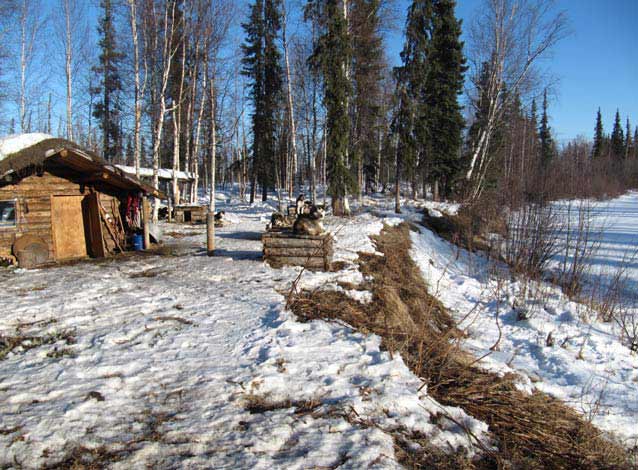
© Miki & Julie Collins
These extremes are more frequent and last longer. We have seen warmer weather, especially in the fall and winter, extremely late freeze-ups, record or near-record rainfall, longer droughts, more significant windstorms, and these creepy winter rains. Not many people remember that 2004, the worst wildfire year in Alaska history, had exceptionally rainy weather during May before the drought began. In 2013, we had the latest breakup anyone could remember; in 2014, the earliest.
While I have no proof that these unusual conditions are from climate change, I can say that they affect our lives, from how we plan our subsistence activities and the way we travel to our simple enjoyment of (or frustration with) the wilderness. The land and water, so familiar and cherished, sometimes act foreign and unpredictable.
At 11 miles long and three to five miles wide, Lake Minchumina is considered to be the largest lake in interior Alaska, yet it is actually just a remnant of a much larger body of water that formed prior to 34,000 B.P. (Alaska Anthropological Association 2012). Backed to the north and west by gentle birch hills and the rugged Kuskokwim Mountains, much of the original lake has filled in with Foraker River silt carried from Alaska Range glaciers. During our lifetime the average lake level has dropped almost six feet. However, ancient shorelines well above the current ones tell us that this process is not necessarily a recent development. Can we blame climate change? Who knows?
Instead of insisting that climate change caused this or that, we are simply going to list some of the changes that we have witnessed and tell how they affect our lives. Maybe someone with more expertise can sort out causalities.
Trapping
Rivers now usually freeze two or three weeks later than in the 1980s, delaying our departure at the most important time of the trapping season. We cannot access our primary trapping areas in Denali Park until we can safely cross frozen rivers and streams. When we began subsistence trapping full time in 1981, we usually crossed those rivers during the first few days of November. In the 1990s, late freeze-ups delayed our travels more than half the time, and in subsequent years this hindrance has gotten worse. In 2013, a very late freeze-up coupled with late-November rainstorms and virtually no snow meant trapping was delayed into December (Collins 1979-2014). November 2014 saw less rain, but only a couple inches of snow until early December.
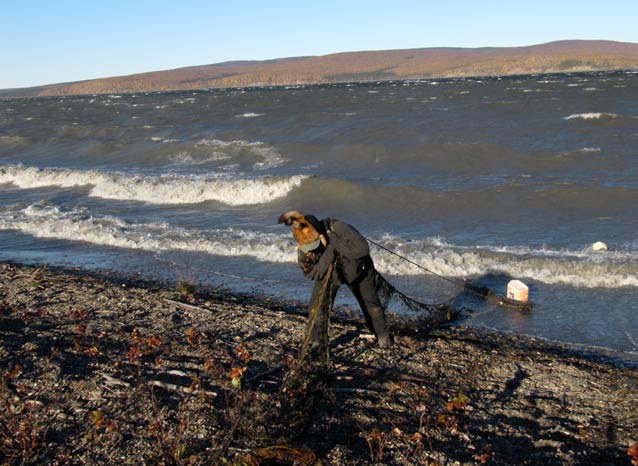
© Miki & Julie Collins
In the last few years, these unprecedented November rains have brought a nightmarish combination of slush, flooding streams, dangerous ice, and melting snow. In addition to creating logistical problems, warmer winters result in fewer top-dollar pelts with their prized dense, cold-resistant fur.
We catch two-thirds of our marten in November and December, before the onset of deep cold and before natural mortality reduces the population. When we lose the first month, it greatly reduces our income. Also, if heavy snows accumulate as we wait for rivers to freeze, this makes heavy going for the dog team, reducing mileage and fur take. This problem was worst during the deep-snow years of the 1990s. Since then, snowfalls have been too light to pad and lubricate the trails, so early travel is dangerously rough. Most years have seen ankle-deep snowfall in early winter, then very little accumulation until February.
This shallow snow cover helps explain the current low wolf population because moose, their long-legged prey, easily elude capture. Warmer weather might explain or contribute to the wolves’ lice infestation that only recently penetrated north of the Alaska Range, and which stresses wolves and can destroy the pelts’ value.
A changing climate can affect hare populations for better or for worse, which causes rippling effects in fur populations. Although steadily-accumulating snow depths allow hares to eat higher up on willows, in this area the last population peak lasted abnormally long despite the low snow. This gave us years of good lynx harvests.
Conversely, marten populations plummeted during this period, possibly because of the high lynx numbers. Marten numbers in our area have been depressed for over 15 years. In one Alaska Department of Fish & Game study, the number of juveniles relative to adults failed to reflect the fertility rates in females (Gardner 2014).
Marten are affected by the microtine populations on which they prey. Dry summers mean fewer of these small rodents, while drenching rains can flood their nests. Forest fires reduce marten populations initially but, unless the fires burn so hot that they destroy the topsoil, the burns eventually regrow into superior microtine habitat and bring in more marten. The voles and other subnivean creatures are also impacted by November rain, which destroys the insulating quality of the snow.
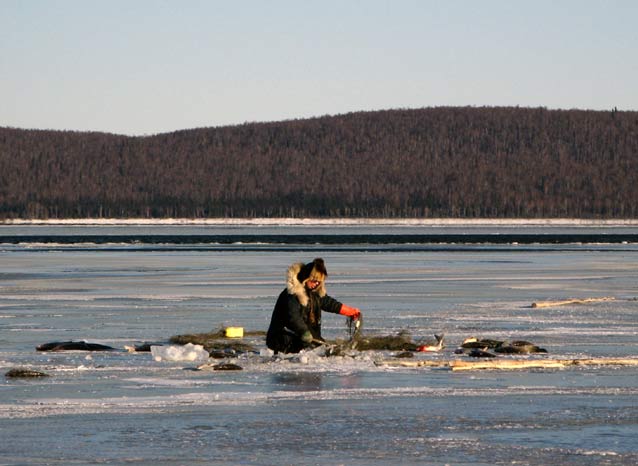
© Miki & Julie Collins
While the marten population has remained low, we are seeing more weasels (ermine). Perhaps these smaller vole-eating mustelids are filling a void left by marten.
Drying lakes reduces wetland habitat, impacting beaver and muskrat populations. (This loss of habitat is not offset by increasing areas of poor-habitat bogs created by thawing permafrost.) The muskrat population crashed statewide decades ago and has only recently shown signs of recovering.
Some permanent sets (trap locations) placed beside drainages must be moved to higher ground every few years and with increasing frequency as thawing permafrost slumps into the water.
Moose Hunting
Climate change can impact moose positively and negatively. Warmer weather allows brush to grow at higher latitudes and elevations so they can expand their range. More forest fires add habitat as burns regrow with choice saplings.
Low-snow years increase moose survival, which will reverse if we return to extremely deep snow. Dry summers and drying lakes reduce forage. Moose also depend on deeper ponds to escape horse flies, which proliferate during hot summers (while mosquitoes have not been as bad). Lower water levels make it harder to access marshy hunting areas and bring out meat. Conversely, storms and flooding can drown calves and cover pondweed to a depth that moose may be unable to feed on it. Invasive plant species that proliferate due to climate change could displace moose browse. Our chokecherry trees with their poisonous leaves have started spreading by seed in the last 15 years, which they never did before.
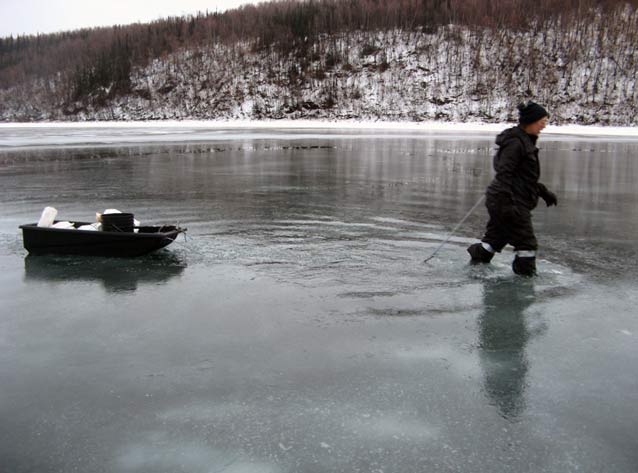
© Miki & Julie Collins
In the late 1990s many of the mature alders along local rivers died, reducing important autumn moose forage. Since alders fix nitrogen, this die-off could also negatively impact soil fertility.
If climate change does increase the moose population, this makes it easier to find our winter’s meat supply. Good calf survival means more young bulls which we prefer to tough old moose.
The massive size of mature bulls makes them overheat easily. While the rut is triggered by the decreasing day length, unusually warm September weather reduces rut activity because the bulls overheat. This puts the rut out of synch with the legal hunting season. (State and federal authorities have been shifting the season later in some game units.)
Warmer fall weather and delayed freeze-ups also make it difficult to let meat hang outside until winter weather freezes it. The long tradition of sawing frozen roasts from a hanging leg of moose may die out if we continue to see above-freezing weather for most of October.
Fishing with Gill Nets
Over the decades we have caught fewer and fewer whitefish to feed our sled dogs despite greatly increasing our efforts. However, the last three years have given us fish numbers that we haven’t seen since the late 1970s, possibly due to cooler summers and higher water. Warmer water reduces fish movement while wind and high water both increase fish catch.
During the whitefish spawning runs in the fall and early winter, we hope to freeze 800 to 1,200 fish for winter dog food. Despite warmer autumns, whitefish spawning seems to start earlier and run longer, so the run dribbles through. Fish caught in an early run can’t be frozen outside (especially with the delayed cold temperatures) and a long thin run means more fishing effort. The recent slow late freeze-ups also push back the date that we can safely set nets under the ice for more productive catches. On the other hand, warmer weather and thinner ice result in less effort to open frozen fishing holes and keep nets running through December.
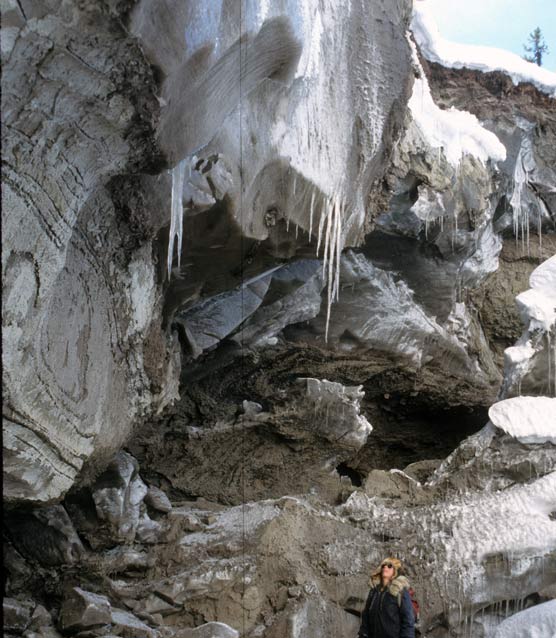
© Miki & Julie Collins
When wind storms blow the snow away, fishing holes freeze faster and working on the slippery ice is difficult. The early heavy snows in the 1990s created serious overflows and dangerous ice conditions. (While checking one net with a pack horse, I did not realize the ice had deteriorated dangerously until my horse alerted me to the peril.)
The lower water level has reduced shallow-water habitat that is important to young fish. Whitefish used to move freely between Minchumina and outlying lakes and ponds, but many of the smaller bodies of water are now land-locked or drying out.
Gardening
Between 1970 and 2010, our growing season lengthened by 20-40 days. The accepted frost-free season used to be June 1 to September 1, but in some recent years the last frost occurred in April and the first fall frost hit in October. In the last three years, we have seen somewhat more normal freezes in September, but winter has still been significantly delayed.
Despite several cooler, rainy summers, we also see longer droughts which increase irrigation efforts and reduce yield and quality. Warm, dry weather helps our heat-loving plants (corn, squash, beans, pumpkins and tomatoes) but stresses the cole crop varieties and root vegetables, thus expanding the range of vegetables we can cultivate, but reducing the quality of the cold-weather plants that are our staple crops.
Pounding deluges wash out seeds, batter delicate crops and cause erosion; frequent rain increases weeds and mildews.
Pests and plant diseases are likely to appear or increase with a longer, hotter growing season or when plants are stressed. Invasive plants may be spreading faster, including seeds imported in hay, straw, and commercial garden sets, and ornamental or experimental plants that run wild. We’ve seen the spread of chokecherry, hempnettle, dandelion, hawksweed, pepper grass, and fox tail (in addition to the many weeds that accumulated after the land was first settled in the 1920s).
Starting in the late 1990s, our highly productive domestic strawberries became increasingly diseased until we had to destroy the patch. The cooperative extension service identified scorch, a fungal disease normally killed by cold winters. However, we are not confident of this diagnosis.
Other Harvest
Warmer temperatures certainly demand less firewood for heating the home and trapping cabins. With the recent early spring thaws and their dwindling snow trails, we’ve sometimes been forced to choose between hauling summer supplies or filling the wood shed (with wood stacked in the forest the previous summer). Early springs do allow us to start wood-cutting sooner in April when the snow softens, but birch trees must be cut down earlier to beat the spring run of sap. We are seeing more lichens and fungus growing on birch trees, not just gnarly old trees but also young and prime ones.
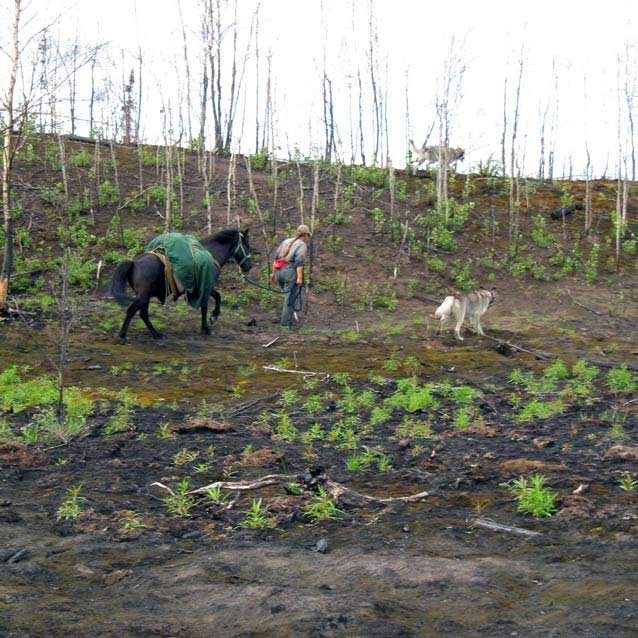
© Miki & Julie Collins
Blow-downs of large trees are common in dry windy years when the soil lacks water to anchor the trees.
Hot dry weather or very cold wet weather reduces the quality and abundance of berries. Our main wild berries are raspberries, blueberries, and cranberries. In 2014, following a very early spring and a cool, wet summer, we saw a poor raspberry harvest and a dismal crop of blueberries and cranberries. When blueberries and cranberries fail, we increase bear alertness, knowing that the bears are hungry.
Blueberries and morel mushrooms thrive in many burned areas and may benefit from more wildfires if the fires don’t destroy the organic materials in the underlying soil, and if the new growth gets adequate rainfall.
Travel
Warm weather and early heavy snows create overflow on lakes and swamps that greatly impedes winter travel. Conversely, low snow accumulations and cold weather will freeze spring-fed streams to the bottom, leading to flooding and glaciering (layers of frozen overflow) on top of the ice. Any water under the snow creates treacherous conditions, especially in bitterly cold weather. With the warmer winters, we have encountered less overflow in the last 15 years despite low-snow conditions.
As the average temperature rises, permafrost warms enough to become unstable. When the thawing soil slumps in trapline trails, it requires strenuous travel or re-routing of sections of trail. Some slumps that developed in our trail are over 10 feet deep. Most are associated with water erosion, such as where the trail crosses gullies that sink deeper and deeper into the permafrost, or where a creek undercuts whole sections of trail that collapse into the water. Although our trapping area was established almost a century ago, after inheriting it we re-opened 100 miles of old trails and never found jags where the original trail had been re-routed around eroded ditches or riverbanks. In the 1980s, we moved the trail in a couple of places where permafrost thaw made it impassable. We made several more detours in the 1990s, and over the last 15 years we find ourselves cutting detours almost every year.
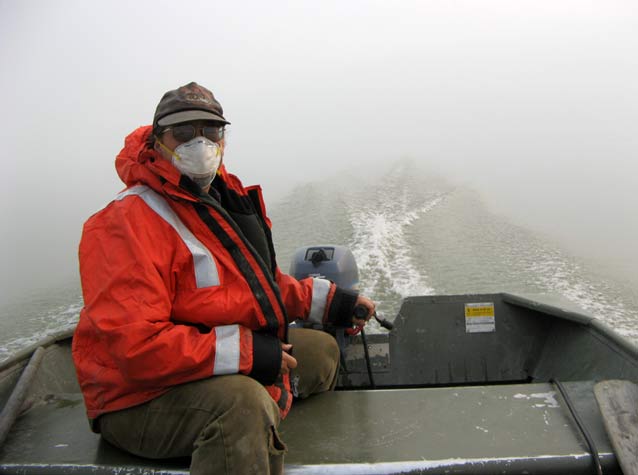
© Miki & Julie Collins
The worst permafrost slumps seem correlated more to summers with torrential rains rather than to hot summers. A level spot becomes a jarring hole, which erodes into a sled-eating ravine. As creeks and rivers deeply undermine frozen ground, large sections cave in, sometimes carrying bits of trail along. These upheavals cause delays, extra trail work, and broken sleds, and can potentially injure sled dogs or travelers.
Following a late-1990s statewide die-off of tamarack trees from insect infestation, the dead blow-downs have been cluttering up our trails for almost 15 years. Burned-over trails require extensive work to reclaim and make travel difficult for decades due to toppling trees, more snow drifting, and possibly increased melting of the exposed permafrost.
Along our trapline, normally shifting glacier streams are stabilizing, incising their channels deeper while sand bars are becoming overgrown. The steeper banks and new brush interfere with winter travel and make summer travel problematic as brush impedes walking and swift rivers tend to be deeper instead of spread out. Overland summer travel is also hampered by heavier summer rains that flood streams and rivers, and by increased brush above treeline.
Animal Husbandry
In warm weather sled dogs overheat while working, but it is easier to keep weight on the animals, which saves on the food bill. Winter rain—increasingly common—stresses sled dogs and especially horses. Snow levels impact whether the horses can forage effectively, which affects our work load and feed bill. Drier summers or flooded grasslands reduce horse forage. Early winter rain makes bluejoint grass unusable for bedding straw in dog houses.
Other Observations
In the last few years we have seen fewer geese, terns, shore birds, song birds, hawks and owls, but more bald eagles and robins.
The Foraker River, which feeds Lake Minchumina, recently shifted so that over half of its water diverts around the lake, contributing to lower lake levels. The change occurred partly because permafrost subsided so it no longer barred the way, but also from natural filling and shifting. A small stream upriver also diverted its outlet to take advantage of thawing permafrost.
While permafrost thaw has always caused submersion of black spruce bordering lakes and marshes, this process is increasingly rapid in some areas. Although sad to see, it does provide us with more dead spruce for firewood.
During dry summers, moss insulating trapping cabin roofs is more likely to die or turn grassy (a fire hazard). As forest fires destroy larger areas more frequently, trapping cabins are at increased risk of burning.
References
Alaska Anthropological Association. 2012.
39th annual meeting. Seattle, WA.
Collins, M., and J Collins. 1979-2014.
Dog Log. Private collection.
Gardner, C. 2014.
Personal communication.
Part of a series of articles titled Alaska Park Science - Volume 14 Issue 1: Resource Management in a Changing World.
Last updated: October 26, 2021
